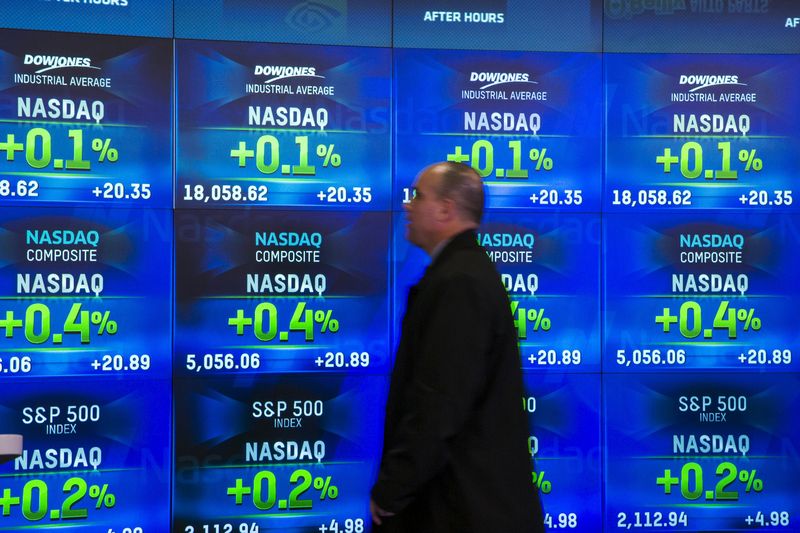Investing.com - UBS has modelled five scenarios that could shape the investing outlook for 2025/2026, as it publishes its Global Market Outlook.
The first scenario sees former President Donald Trump winning the presidency while Republicans win both houses of Congress, though fall short of a filibuster-proof majority in the Senate - the so-called Red Sweep.
Fiscal policy in 2025 is roughly baked in, as most of the spending and tax policies are already in place, based upon existing agreements between the parties. But beyond 2025, big changes loom: most of the tax cuts enacted under the Tax Cuts and Jobs Act in 2017 expire at the end of that year.
“We do not assume that the Red Sweep would result in a simple extension of the TCJA, but we do assume the bulk of the TCJA would be extended,” analysts at UBS said, in a note dated Oct. 9. In all, relative to the CBO baseline, we estimate the fiscal deficit would increase by $4.4 trillion and run over 7% of GDP after 2028 — most of which would be the cost of maintaining the status quo.
An additional feature is a cut to corporate taxes estimated to cost about $600bn over the 10-year window, which could be roughly fully funded by repealing the energy tax provisions in the Inflation Reduction Act.
Tallying it all up, the deficit would potentially widen $4.4trn over the budget window relative to the CBO baseline where many current tax deductions would have expired. However, the vast majority of this spending is meant to keep the existing tax code in place rather than significantly cutting personal taxes.
The corporate tax cut could potentially spur a little growth, however, combining this domestic tax policy mix with harsher China tariffs implies that deficit-widening relative to current law may not be all that stimulative for growth.
The second scenario sees Vice President Harris winning the White House, with the Democrats retaking the House of Representatives and potentially holding on to the Senate - the so-called Blue Sweep.
The Harris campaign has proposed returning the top tax bracket to 39.6% for single filers' earnings over $400K and joint filers' over $450K, as was also proposed by the Biden administration.
This policy could offset the widening from extending for other income groups by ~$400bn over the budget window, meaning the total cost of bracket extension for all other groups would be ~$1.7trn in lost revenues.
Overall, despite a number of revenue raising proposals, the Harris campaign policies are likely to widen the deficit by ~$2trn over the 10-year budget window.
Balancing the tax hikes on upper incomes and corporations and tax cuts for the lower end of the income spectrum, we estimate Q4/Q4 growth would be ~0.3pp and ~0.1pp lower in 2026 and 2027, respectively, in the Blue Sweep scenario relative to our baseline.
The third scenario sees the US economy in recession, a risk that should diminish over time, if the Fed manages to deliver the easing that is priced.
For all the good news on the economy, signs of household stress have spread.
Credit card and auto loan delinquencies are near or above global financial crisis levels. The highly liquid balance sheets have now completely evaporated for the bottom 80% of the income distribution, while even among the wealthy, the post-Covid spending spree may run out of steam.
Business surveys look mixed at best, parts of investment and construction are slowing sharply, and slower government spending is starting to weigh on activity. The cyclical, interest-sensitive part of the economy has looked recessionary for a while, but strong consumption has broken the usual transmission link.
In this scenario that changes: consumer spending finally slows to the point of breaking corporate confidence about demand. Less spending feeds into lower hiring (negative payroll growth) which feeds into lower spending and rising precautionary savings.
The Fed, realizing that it needs to be outright accommodative rather than just less restrictive, takes the Fed funds rate back to the lower bound.
The fourth scenario centers around tariffs, with one of the most consequential proposals put forward by former President Trump is to increase the level of US tariffs on China to 60%, and on the rest of the world to 10%.
Should such tariffs be implemented, we believe the legal process would make it unlikely that China tariffs are implemented before the second half of 2025 (we assume September) while RoW tariffs would be a 2026 event.
Most of the literature suggests that the costs of the US tariffs in 2018/2019 were borne by the US, in that Chinese firms did not lower prices to preserve market share. But the volume of imports from China (and its market share) fell sharply, by 22% in the first year, on average, and by 36% after 5 years).
We expect significantly more focus on 'rules of origin' to avoid tariff circumvention.
Finally, the fifth scenario centers around central banks having eased too early.
Central bank easing has started – with close to 70% of all the central banks under the bank’s coverage having now started lowering interest rates – despite still elevated run-rates of core inflation, and 63% of central banks missing their inflation targets.
The logic of the 'why cut now?' seems to be in part to ward off potential further slowing. That said, we are not aware of prior episodes where this much easing was priced by markets when labour markets were still this tight.
Although we are not in the 'sticky' inflation camp, premature easing could contribute to a slower 'last mile.’
Global growth outside of the eurozone and China is already running a bit above its long-run average. It is not hard to imagine that, if the US does not slow as we forecast, and eurozone consumption finally starts to take off, or more stimulus from China is announced, that the global economy picks up momentum, pushing growth above trend.
